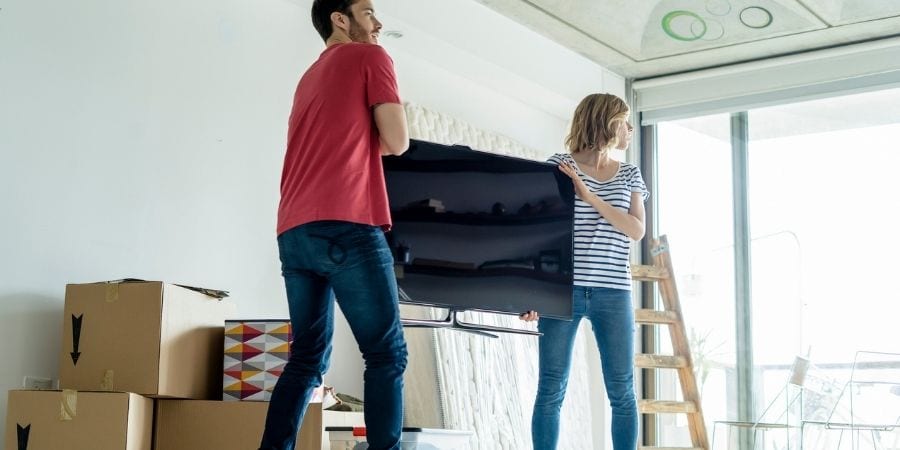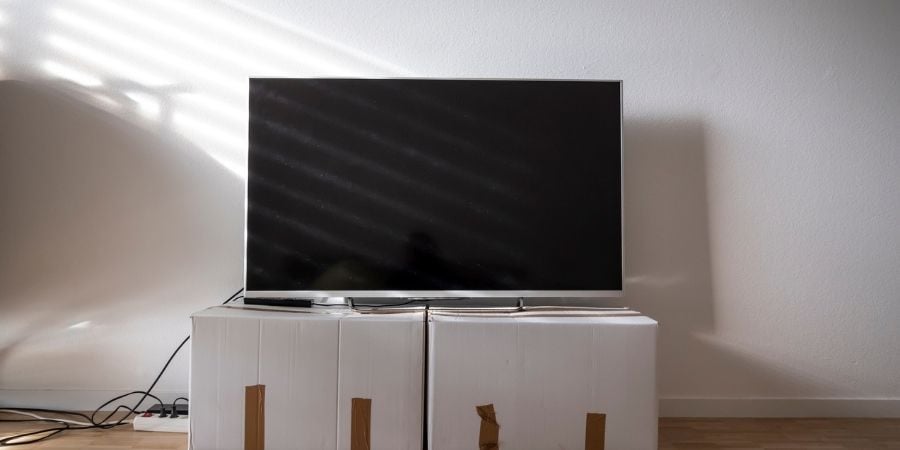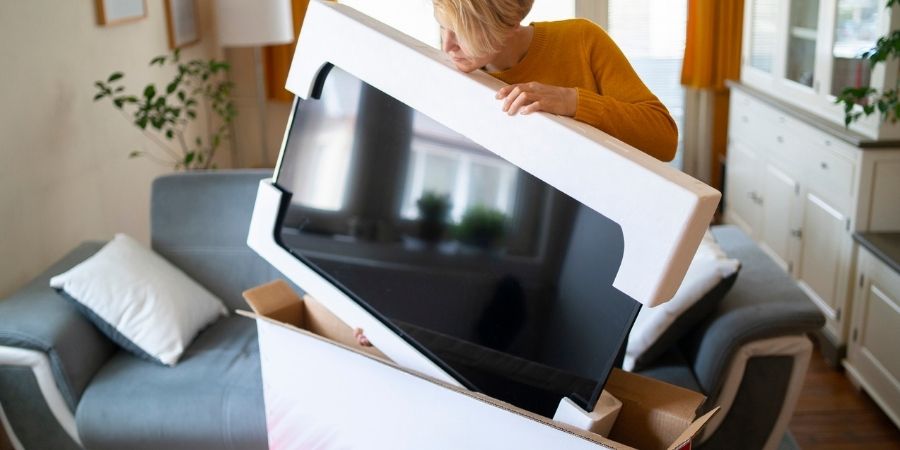A television is often one of the most expensive, fragile electronics you own. So you want to make sure that it arrives at your destination in working condition.
In this article, we’ll share some packing tips that may help keep your TV safe and secure, whether you’re transporting it in a car or a moving truck.
What you need to know about transporting a flat-screen TV
When taking your TV to a new place, there are a few things you should ask yourself:
Should you lay it flat or keep it upright?
What’s the best way to pack a TV for moving?
What should you do if you no longer have the original box?
We’ll answer all these questions and more.


What supplies do you need to pack a TV?
The supplies you need are the same supplies you’ll need for packing or moving other items in your home, so you should already have most of the packing materials on hand.
A box for the television
Bubble wrap
Moving blankets or other soft materials
Packing tape
Plastic bags or a smaller box to put the TV’s accessories
Rope or bungee cords to help secure the TV
Extra blankets, clothes or crumpled packing paper to fill any extra space inside the TV box
Can you lay a TV down when moving?
You should avoid laying a TV flat when moving, which could damage it. Though some people think it’s because the plasma crystals get damaged, this isn’t true.
Larger flat-screen televisions are weight-balanced when standing upright. So if you put the TV flat, it could mess with the weight distribution, since the middle isn’t sufficiently supported. This increases the chance that a bump in the road or any other vibration could crack or distort the screen.
That’s why you should transport a television upright, preferably securing it between two items that will help support it in the event of a bumpy road.


How to pack a TV for moving?
TV boxes can be cumbersome and awkward to save, especially with limited space. But that doesn’t mean you can’t still protect your TV when you move. If you’ve tossed the original box, there are other methods you can use to keep your TV safe.
You should purchase a moving box specifically made for transporting TVs. These boxes come with additional padding for the inside, like foam, air bags or a screen protector.
But if you have to move a TV last-minute and don’t even have the time to find a moving box, here’s how to transport it without a box:
Wrap the screen in multiple layers of bubble wrap.
Secure the bubble wrap to the flat-screen TV with tape, but avoid getting any on the screen.
Then, wrap the TV once again in a soft, cushioning material like a blanket or moving blanket.
Secure the blanket to the TV with tape, rope or a bungee cord.
Make sure to transport the TV sitting up, not flat!


Should you keep your TV’s original box for moving?
Most original TV boxes are ideal for moving your TV—if you didn’t throw it out. These boxes often come with foam corners and other padding inside the box that help prevent your big screen TV from shifting.
If you’re using this method, here are some moving tips to help you pack your TV:
Make sure to remove any cords and cables since leaving them connected may scratch or break the screen. Screws may get lost if you keep them connected, so it’s crucial to remove them, too.
Disassemble the TV mount and base, carefully adding screws into a clear plastic bag.
Wipe down your TV and accessories with a microfiber cloth or electronic wipes to clean off any dust before packing.
Re-wrap your TV in the protective covering it came in. If you have the box but have tossed the packing materials, you can use a soft blanket or layers of bubble wrap in a pinch. Secure the covering to the TV with tape. Avoid getting any tape on the screen.
Take your plastic bag of screws and tape it inside or outside the TV box.
If there’s any space inside the box, add crumpled paper or additional blankets to keep it from shifting.
If your TV is particularly heavy, here’s a helpful tip: Turn the box on its side so the opening faces you and prop a pillow next to it. Tilt the TV so the screen is facing up and the back rests on the pillow. Gently push it over the cushion and into the box. Add any additional packing material to keep it from shifting.
Seal the TV inside the box and label it as “Fragile.” Don’t forget to mark which side should go up.
Take any leftover cords, cables, mounting brackets and other accessories and add them to another small box or bag. Label this box and try to keep it with your TV.
Pro tip: Take a picture of the bottom or back of the TV when all the cords and cables are still plugged in, so you’ll know how to re-attach everything later.


What is the best way to place a TV in a vehicle for moving?
If you’re transporting a new TV in a car or small vehicle, you can place the TV in two main areas: In the car's trunk or behind the front seats. Placement will depend on the size of your vehicle as well as the size of your flat-screen TV.
Before even moving the flat-screen TV, you’ll want to make sure you can fit it in your car. Smaller cars like hatchbacks or sedans may not provide enough room for your new electronics, so you should make sure they can fit in your vehicle. Otherwise, you may have to rent a larger car last minute.
Whether you place it in the back seat or the trunk, you should always put it upright. As we mentioned earlier, if it’s placed on its side, it could break or crack. Put down a layer of something soft and plush, like packing paper, a blanket or even a few t-shirts.
Then, wrap or box the TV tightly, carefully lifting the box and placing it into your car. If there is a lot of space around it, or the television seems a little shaky, you should add additional padding to reduce movement.
Moving? Now's the perfect time to get a home security system.
At ADT, we can help you customize a home security system for your unique circumstances. Whether you need help picking out a smart thermostat or if you need help setting up a new security camera system, we’re here to help.
Frequently Asked Questions about Packing a TV for Moving
Is moving a TV bad for it?
If properly handled and wrapped, you should successfully get it to its destination. Just remember that you should always keep it upright, instead of laying it on its side, since this could damage the screen.
How to measure TV size for a moving box?
Typically, to measure your TV, you would go diagonally, from the top right corner to the bottom left corner of the screen, not including the borders. But when you’re measuring the TV to see if it will fit in your car, you do want to include these measurements.
Can I carry a TV by myself?
One person can successfully carry a 40-inch TV, but you’ll want to be careful. As for a 65-inch TV, this may be a bit more difficult for a single person to carry. If you have any concerns, you should hire professional movers or employ a few friends to help you move.
However, if you pay for a full-service moving company, then they will do all the work for you—including boxing your items up.
Do’s and don’ts of moving a TV?
Do take pictures of the plugged-in cables before unhooking everything for easy re-connection later.
Don’t pack it with its accessories since they may scratch the TV screen or get lost.
Do dust and clean your TV and its components before packing it.
Do make sure you wrap it thoroughly to prevent breakage.
Don’t lay the TV on its side when transporting it.
Do label the box as fragile and indicate which side should go up.
Don’t install a flat screen over a fireplace.
Related Articles:


